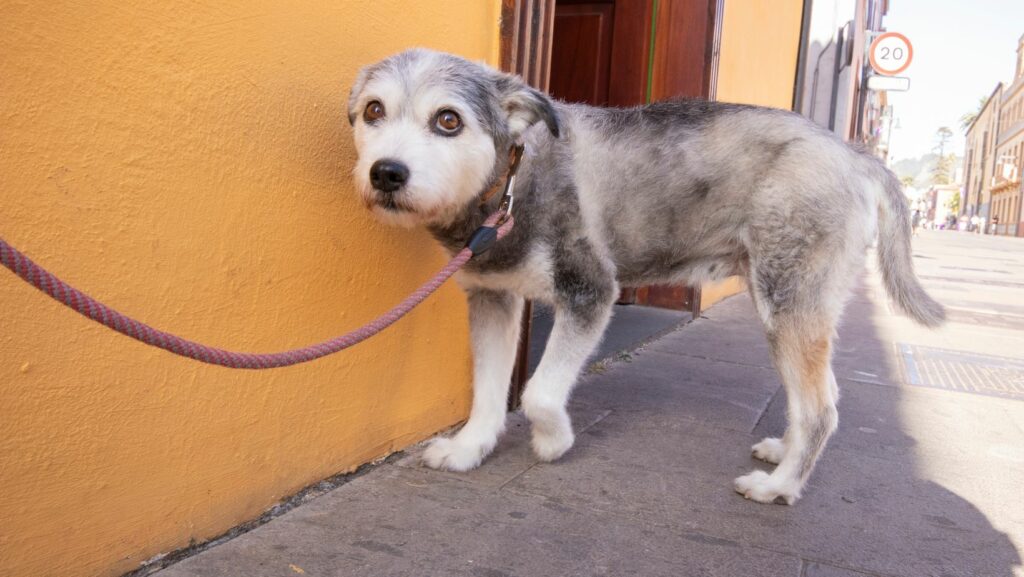Have you ever encountered a dog that avoids eye contact, shies away, or even growls when you try to approach? Seeing a dog in distress can be heartbreaking, but with patience and the right approach, you can help them feel safe and secure. Building trust with a stressed or fearful dog takes time and understanding, but the reward of seeing them relax and connect with you is truly special. It’s not just about making the dog feel better; it’s about creating a lasting bond based on trust and comfort.
When dealing with a fearful dog, every action you take can either help or hinder their progress. Small steps, like respecting their space or rewarding calm behavior, can have a significant impact. With some thoughtful actions and consistent care, you can make a meaningful difference in a dog’s life, transforming fear into trust and helping them feel safe again.
Start Slow and Respect Their Space
When approaching a stressed or fearful dog, the first step is to respect their space. Rushing toward them or trying to pet them right away can make them feel even more anxious or threatened. Instead, give them time to observe you from a distance and decide when they feel comfortable enough to come closer. Sitting or standing calmly without forcing interaction allows the dog to make the first move, which builds their confidence.
Avoid direct eye contact, which some dogs may perceive as a challenge, and keep your movements slow and predictable. Even if the dog doesn’t approach immediately, patience is essential. Over time, they’ll start associating your presence with safety rather than fear. Respecting a dog’s boundaries shows them that you can be trusted, which is the foundation of building a strong bond.
Use Positive Reinforcement
Positive reinforcement is one of the best tools for helping a fearful dog feel more comfortable. Reward calm and desirable behavior with treats, gentle praise, or toys that the dog enjoys. Even small actions, like looking at you or staying relaxed in your presence, deserve acknowledgment. This method helps the dog associate you with positive experiences, gradually reducing their stress and anxiety.

Consistency is key when using positive reinforcement. Make sure to reward the dog every time they display good behavior, no matter how small the progress may seem. Avoid punishment for fearful actions, as it can worsen their anxiety and set back the trust-building process. With time, positive reinforcement strengthens your bond and helps the dog feel more secure around you.
Keep a Calm and Predictable Environment
Fearful dogs often thrive in calm and stable environments where they know what to expect. Sudden loud noises, chaotic surroundings, or too many new people can overwhelm them and make it harder for them to trust. Creating a quiet space where the dog can retreat when they feel overwhelmed is crucial. This might include a comfortable crate, a quiet room, or even a corner of a room where they feel safe.
Try to keep your interactions consistent, using the same tone of voice and body language to reassure them. Predictability helps reduce fear because the dog learns that there are no surprises when they’re around you. Over time, this controlled environment allows the dog to relax and focus on forming a bond with you. A calm setting is one of the simplest yet most effective ways to help a dog overcome fear.
Understand the Dog’s Triggers
Fearful dogs often have specific triggers that make them feel stressed or scared, such as certain noises, unfamiliar objects, or sudden movements. Observing their behavior and identifying these triggers is essential for creating a safer environment. For instance, if the dog reacts negatively to loud noises, providing a quiet space during storms or fireworks can make a big difference. Recognizing what upsets them allows you to take proactive steps to minimize their exposure to those triggers.
Working gradually to desensitize the dog to their fears can also help. This involves exposing them to the trigger at a low intensity while pairing it with something positive, like treats or praise. Over time, the dog may begin to feel less afraid. Understanding and addressing a dog’s triggers is a critical part of building trust and helping them feel safe.
Be Patient and Consistent
Patience is one of the most important qualities when working with a stressed or fearful dog. Progress often comes in small steps, and some days might feel like setbacks. Staying consistent in your actions, tone, and approach helps the dog feel more secure. Dogs are highly sensitive to emotions, so remaining calm and positive reassures them that they’re in a safe space.

Celebrate small victories, like the dog coming closer to you or showing relaxed body language. Each step forward is progress, even if it feels slow. Consistency builds a sense of predictability for the dog, which is key to overcoming their fear. Trust takes time, but your patience will be rewarded as the dog begins to feel comfortable and confident around you.
Seek Professional Help When Needed
If a dog’s fear is extreme or if you’re unsure how to handle their behavior, reaching out to a professional trainer or behaviorist can be incredibly helpful. These experts have the experience to create tailored strategies for dealing with the dog’s specific needs. They can teach you techniques to manage the dog’s fear safely and effectively. Seeking professional help doesn’t mean you’ve failed; it means you’re committed to doing what’s best for the dog.
If the situation involves a dog that has harmed someone, such as through a bite, it’s also important to understand your legal responsibilities. Consulting legal representation for dog attacks at the Fang Law Firm can help you navigate these challenges while protecting the dog’s future. Professional support ensures both you and the dog are equipped to handle difficult situations.
Celebrate Small Victories
Every step forward, no matter how small, is worth celebrating when working with a fearful dog. Whether it’s the first time they take a treat from your hand or the first moment they relax in your presence, these milestones represent progress. Recognizing and rewarding these achievements not only builds the dog’s confidence but also strengthens your bond.
Each victory, no matter how small it seems, is a sign that trust is growing. Over time, these moments add up to a significant transformation in the dog’s behavior and comfort level. Celebrate these steps as they show how far both you and the dog have come. Trust-building is a journey, and every small victory matters.
Building a Lifelong Bond
Helping a stressed or fearful dog learn to trust is a journey filled with patience and dedication. Watching a dog go from fearful and unsure to relaxed and confident is one of the most rewarding experiences for any dog lover. The bond you create through consistent care and understanding will last a lifetime.
It’s not about rushing progress but embracing each moment as a chance to deepen your connection with the dog. Every kind action, every calm interaction, and every small victory lays the foundation for a lifelong relationship built on trust and love. Your efforts can change a dog’s world, helping them feel safe, happy, and valued.

